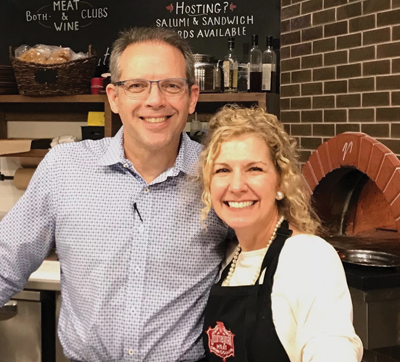
North Bay companies are doing brisk business in 2022, but profit margins are being undercut by the highest jump in consumer prices in 40 years. Businesses are also experiencing supply chain disruptions. As CEOs head into fall, they’re preparing for harder times by forming partnerships, limiting hours, and adding to their customer base. “Local businesses have learned inflation makes it impossible to have the same profit margins as before the pandemic. Their question is: What’s our new target? The answer pushes them to be resilient and plan for the future,” says Lauren Cartwright, interim director of business development for the Sonoma County Economic Development Board (EDB).
CEOs should especially keep an eye on housing and energy prices. These are key indicators of spending power, says Robert Eyler, Ph.D., professor of economics at Sonoma State University. “After food, the most regular expenses are rent or a mortgage, utilities and gas. When prices for these go up, residents and visitors have less money to enjoy local products and services,” says Eyler.
One way to make it through a more difficult year could be regular assessment of regions and sectors. The effort can help a set of businesses estimate demand and adjust prices. Tim Zahner, executive director for Sonoma Valley Visitors Bureau, says the pent-up domestic demand for leisure travel has dropped a bit since Europe reopened. The return of conferences has brought mid-week visitors to the area. “The lessons our hospitality businesses learned earlier during the pandemic will carry them through this period,” says Zahner. “Offering pleasant and accessible outdoor dining, introducing outdoor recreation opportunities, and ensuring businesses recommend one another, such as a winery suggesting a restaurant, creates a web of cooperation.”
Tourism and trends
In 2021, tourism saw a healthy rebound. Visitor spending rose by 28% in Marin County and 58% in Sonoma County. Recovery to pre-pandemic levels may take between two to three years in Napa County, according to Linsey Gallagher, president and CEO of Visit Napa Valley. Visitors spent $469 million in Marin County and $1.97 billion in Sonoma County in 2021.

A number of issues are creating headwinds for the hospitality industry. Workforce shortages, high gas prices, inflation, talk of a recession, and continued health and safety challenges are all concerns for the hospitality industry and potential visitors. In some cases, businesses need to limit service or hours of operation as a result. “With our core customers coming from the Bay Area out to Sacramento, we are watching how these issues may impact their travel decisions,” says Claudia Vecchio, president and CEO of Sonoma County Tourism. “We will watch activity very closely and balance our marketing outreach to match the needs of our local businesses and potential customers.”
The fact that U.S. wine consumption is on the rise, up to 3.18 gallons per person in 2021 from 2.93 gallons in 2018, further benefits North Bay tourism, says Chris Thornberg, Ph.D., founding partner for Beacon Economics, a consulting firm in Los Angeles. Thornberg gave a talk about the wine industry to the Sonoma County Winegrape Growers in July. “Right now, there is not a decline in consumer spending. Household net worth increased substantially in 2021. Consumers are still coming to the North Bay for wine and experiences they couldn’t get in 2020,” says Thornberg.

Napa is cautiously optimistic about growth, says Vincent Smith, community development director for the City of Napa. “For hotels, occupancy is slightly down. Yet guests are staying longer. That results in a positive bump for wine, restaurants, and retail stores. Due to extraordinary local support, we saw very few restaurant closures during the pandemic. Currently the City of Napa is working on diversifying our economy. We’re deepening our relationship to health care-related businesses. We’re exploring opportunities to create more spaces for artists and artisans,” says Smith.
Smith says retail in Napa is shifting to an “experiential approach.” Guests want to see, touch, and feel items they purchase. “We’re also putting more emphasis on spring travel. Spring is a wonderful time to enjoy Napa, without the hot and dry weather of harvest season,” says Smith.
North Bay trends for tourism include wellness and self-care, relaxation, and outdoor recreation. “Before the pandemic, people wanted to go places they hadn’t been before. Now people want to go to places that are familiar and comfortable,” says Vecchio. “Of course, they still want to enjoy excellent food, wine, and recreation.”

Educating guests and residents about how to maintain the natural environment is helping the area remain safe and inviting. This year, Marin, Mendocino and Sonoma counties extended their partnership with Leave No Trace, a Colorado-based nonprofit that addresses stewardship issues including coastal trash and litter.
Andrew Leary, director of sustainable tourism and partnerships for Leave No Trace, says local businesses play an important role in sharing responsible messages with residents and visitors. “We have seen a tension between increases to public lands visitation, all while parks and protected areas, out of necessity, pare back staff, close facilities such as visitor centers and restrooms, and suspend services such as trash pick up,” says Leary. “Leave No Trace education and instilling values of personal responsibility are more important than ever during these critical moments.”
Bert Rangel, co-owner of River’s End Inn & Restaurant in Jenner, has seen positive impacts from leaving “mindful nature notes” for guests at the Inn’s

cabins. A small reminder in a welcome email states guests should maintain a safe distance from wildlife—“seals require at least 150 feet”—and follow local rules regarding natural resources. “We bought a few homes around the area to add to our lodging, but are focused on giving guests a better experience. We’re capping reservations so we can really show off our town of 90, the views and the ocean,” says Rangel.
More “self-contained” small towns in the North Bay, such as Cloverdale, can see a high number of day visitors from within the county or nearby cities. Building a community of businesses that support one another promotes economic activity downtown, says Neena Hanchett, director of the Cloverdale Chamber of Commerce.
“Cloverdale’s restaurants, in spite of staffing challenges, seem to be doing well,” says Hanchett. “That’s partly because of rental rates being lower than in other parts of Sonoma County. It’s also because we encourage our residents, fellow business owners and visitors to shop and support Cloverdale in print media, promotions, videos and in real life.”

Promoting whatever’s not high in price, “chicken one week and fish the next,” and using the best ingredients has allowed her restaurant’s doors to stay open, says Ana Valverde, co-owner of El Milagro in Cloverdale. “We also held off on getting new floors. We collaborated with Sonoma Family Meal, a nonprofit that provided families in need with meals during the early phase of the pandemic, sponsored Cloverdale Little League, and donated five meals a week as prizes to students in local schools. We’re doing a great deal with an approachable and friendly Chamber to become a local favorite,” says Valverde.

Weathering the pandemic
The lingering impact of COVID-19 remains a significant influence on the North Bay’s economy. The summer surge of COVID increased unpredictability and staffing shortages.
Businesses can decrease the risk of spreading COVID by requiring or asking workers and visitors to wear masks. They can also limit the number of customers in a store, keep social distancing measures in place, and encourage workers to remain home when they are sick or contagious. “If the next variant is a real doozy, the option to institute mandates remains” says Matt Brown, communications specialist for Sonoma County. “We’re looking for businesses to be responsible and help to lower the rate of COVID transmission.”

Local businesses that serve health-care providers are seeing an increase in demand. “We signed a contract with the federal government for $59 million in October 2021. This will double the size of the company. We’ve grown 35% already since March 2020,” says Jim Happ, CEO of Labcon, a medical supplies manufacturer in Petaluma.
One of Labcon’s most in-demand products is filtered pipette tips. The item allows an instrument that picks up a liquid, while preventing the spread of the novel coronavirus. “The U.S. needs more domestically-produced supplies for COVID testing and vaccine development. Our growth helps federal government and healthcare providers avoid getting such supplies from China,” says Happ.
According to Dick Herman, founder of 101 MFG, a Santa Rosa-based state association of manufacturing companies, said supply chain disruptions remain a significant concern for North Bay manufacturers. “Also, the pool of skilled labor isn’t what you could find in San Jose,” says Herman. “Right now, a wide variety of companies are seeing high demand for their products. They’re struggling to up-skill the labor force to become more productive and justify wages of $30 an hour. The companies that are doing well are those that are training a flexible, highly-skilled workforce and automating the mundane, repetitive or error-prone tasks. They are able to dial up or dial back production as the market fluctuates.”
Local agriculture has also been hampered by supply chain concerns and rising inflation. “From gas to equipment, inflation is hitting everyone hard. We’re getting ready to approach harvest. Of course we have concerns about labor,” says Ryan Klobas, CEO of Napa County Farm Bureau. It will be easier to understand the impact of COVID and other issues after harvest, says Klobas. “Everyone always calculates for times of economic uncertainty. The question is whether they will be in the black going into winter,” he adds.

The cannabis industry is suffering as well. Cultivators, manufacturers, and retailers are seeing an oversupply of cannabis. Fortunately, demand remains high. In April 2022, Solful, a Sebastopol-based cannabis dispensary, opened a second storefront in Santa Rosa.
Eli Melrod, CEO and co-founder of Solful, says stress and unspent vacation dollars affect demand. “The State of California deeming cannabis an essential business also helped. It removed the stigma of cannabis use,” says Melrod. “Now cannabis is more widely seen as a legitimate part of the North Bay’s economy.”
Gardening businesses have seen high demand through the pandemic. Still these and businesses that relate to home improvement have seen costs increase during the pandemic.
Ashley Porter, co-owner of Cloverdale Nursery, builds current and future demand by carrying a wide array of products at a variety of price points. “The desire to reconnect to nature was born out of the pandemic,” says Porter. “[It] is one of the few things that we hope will stick. Being in a drought, we have to pivot even more to educate the public…[to] still foster that connection.”
Latino business owners
A responsible way for North Bay counties to ensure their economies remain robust is to support Latino and undocumented business owners. Marcos Suarez, business diversity program manager for Sonoma County EDB, says inflation has hit Latino business owners particularly hard. “If small business owners raise their prices, it could potentially discourage customers from coming in the door,” says Suarez. “With lower-income individuals in particular having decreased spending power, we’re finding new ways to help small business owners be more efficient.”


Suarez says it is beneficial to celebrate the culmination of long-term efforts like the July grand opening of Mitote Food Park in Roseland. “Yet business owners need to keep refining marketing and accounting strategies. Tightening up menus and inventory and focusing on products and services that are most in demand from customers [are] key to businesses becoming leaner ahead of a potential recession.”
In Marin County, Canal Alliance, a San Rafael-based nonprofit that offers career and education services to the Latino community, teamed up with the Marin Small Business Development Center to assist individuals applying for grants for microbusinesses. A microbusiness generates $50,000 or less in gross annual receipts.
The one-time state funding for grants comes from the California Office of the Small Business Advocate. “We’ll be giving out $262,500 to qualified microbusinesses, so 105 grants of $2,500 each,” says Miriam Hope Karell, director of the Marin SBDC. “We are currently in the review process. We do not have any numbers yet on who has received awards. We will be distributing these funds at the end of August and beginning of September. Our statistics show 61% of the applicants were women and 52% were minorities.”

Regina Vindel, workforce career supervisor for Canal Alliance, says language assistance got many small business owners through the application process. Reassurances that undocumented status was not an obstacle allowed new business owners develop the confidence to submit applications. “This is the first time a pandemic funding option was offered that made it easy for undocumented individuals to apply. This funding was accessible to many,” says Vindel.
Suarez adds that Sonoma County EDB is also helping applicants apply for the grants, but fewer individuals in this county are eligible. “That’s because many people already received financial assistance from Cal OSBA earlier through the California Small Business COVID-19 Relief Grant Program. [That] made many of the applicants ineligible [for the newer grant],” says Suarez.
Creative thinking expands options
Collaboration is one of the most constructive tools to prepare for a recession. Pete Seghesio and his wife, Cathy Seghesio, co-owners of Journeyman Meat Co. in Healdsburg, opened their business in 2017. Their first sales came just before Sonoma County was impacted by devastating wildfires.

“We’re used to the rules changing fast. Yet later, during the early phase of the pandemic, they changed really fast, like every month. One effort that has helped us since spring 2021 is a partnership with Cream Co. Meats. They’re an Oakland-based distributor [that] ensures our monthly bacon, salami, and sausages reach customers in the city. We’re also creating a co-branded salami with Snake River Farms, an Idaho-based pork and beef supplier, and making a custom recipe for the staff at Oliver’s,” says Pete Seghesio.
Developing new products and ways of doing business are a guard against rising costs. Seghesio says Journeyman Meat Co. saw growth of 35% in revenue in 2021. “We were so excited. But fuel prices and supply chain issues will bring that growth down to 20 to 24% in 2022. Now we’re solidifying cooperation with select local wineries to create salami that pair with their wines. We developed sliced packs of our cured meats for those wineries which don’t have commercial kitchens. Our recent pivots show it’s possible to advance through chaos,” says Seghesio.
Porter says Cloverdale Nursery began carrying products of small local artisans in its shop. “We’re also [hosting] local pop-ups. We invite a local vendor or baker such as Flour Girl, Renee’s Baking or Obrigado to come set up for free in our space for two to four hours on a weekend day. [This] has been a great success for everyone,” says Porter.
Tips and pain points for local businesses
Businesses looking to prepare for a recession have a valuable resource—local financial institutions, including credit unions who listen closely.

Chris Call, CEO of North Bay Credit Union, says the Federal Reserve’s move to increase interest rates by 0.75% in summer 2022 and an expected move to increase them again another 1.50% by December 2023 will put a strain on local businesses. “Individuals with a variable rate credit card, home or commercial equity line of credit, or personal loan will be hit with larger payments. They can save money by converting to a fixed rate before further hikes,” says Call.
Small business owners who want to sell to larger companies should consider that step before their cost of debt rises. “We’re currently seeing a lot of acquisitions in agriculture and cannabis because owners have been exhausted by wildfires, tax burdens and the pandemic. It may be possible for an owner to get a higher price before recessionary erode profitability,” says Call.
Brett Martinez, president and CEO of Redwood Credit Union, says the organization is currently helping members shift strategies as often as needed. “We have the tools to help companies that have not adjusted from a pre-fire, pre-pandemic business model,” says Martinez. “It’s a good idea for a company to increase its cash flow and reserves before the Federal Reserve increases interest rates.”

Martinez also encourages members to buy reliable vehicles and make necessary repairs before a recession. “The last thing you want is to have a car break down on you when costs are higher. Having assets in good condition allows you to be more flexible,” says Martinez.
Eric Sternberger, partner at Ragghianti Freitas LLP in San Rafael, says
businesses with unpaid rent should not expect further rent concessions from landlords. They can pursue payment plans given worsening economic conditions. “Commercial property owners are often restricted by loan covenants with their lenders as to whether or to the extent they can modify rent contracts,” says Sternberger. “Small businesses who still owe rent from early in the pandemic should expect to repay rent debt.”
As commercial properties continue to sell in this market, having a payment plan for back rent may benefit both the selling landlord and a tenant as ownership changes. “In contrast, there has been a softening of the residential real estate market. The days of multiple cash bids are now the exception and not the rule,” says Sternberger.


Louise Dawson, director of the Sonoma Small Business Development Center, says experience has taught her that negotiation, patience, and community serve North Bay businesses well during rough periods. “Visiting your local SBDC now allows our staff to share how to avoid taking on more than you can handle later,” says Dawson.
She adds that businesses can also prepare for a recession by increasing child-care options, welcoming seniors to hospitality positions, and inviting recent high school graduates to entry-level jobs. All of these steps lower the cost of labor and increase employee retention.
“Another thing local businesses can do is put a focus on mental health,” says Dawson. “Uncertainty from the pandemic and rising costs have caused people to suffer from stress and exhaustion. Motivating employees, offering solutions, and listening to their concerns relieves tension and helps everyone keep going.”



